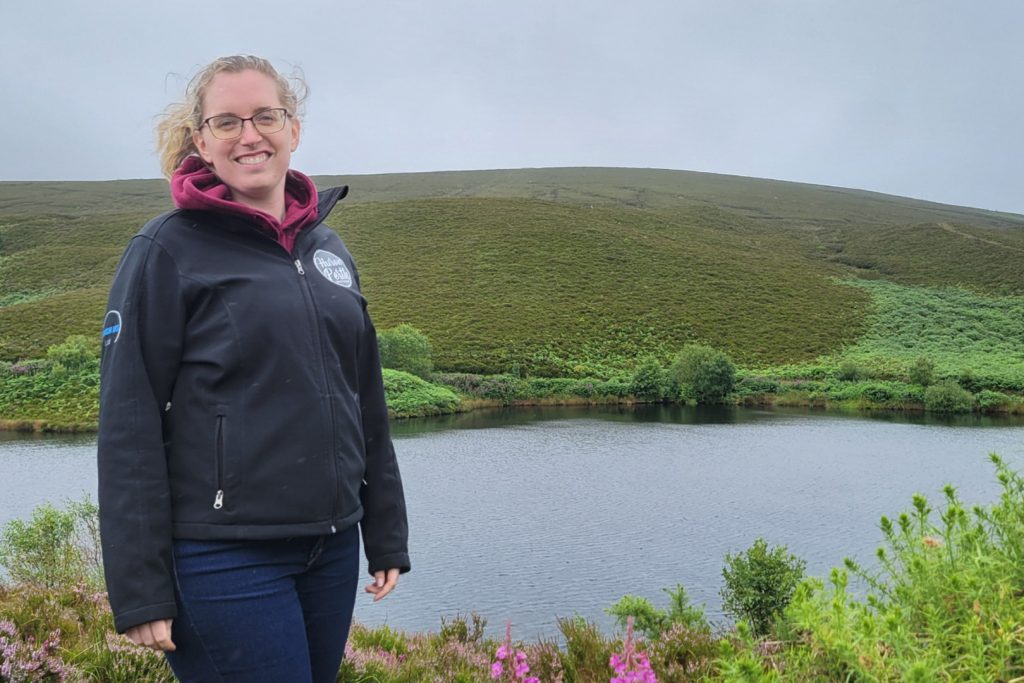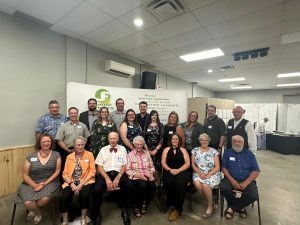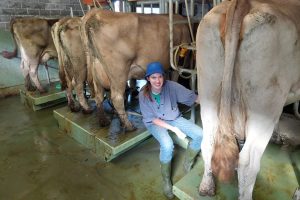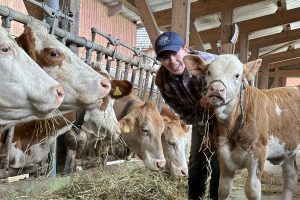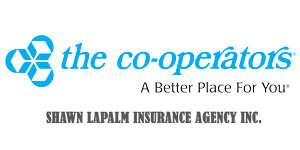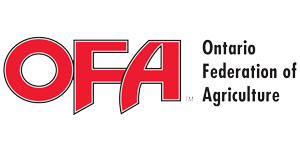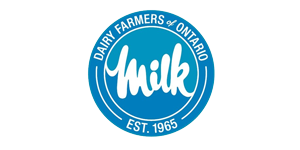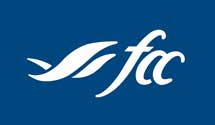I had the opportunity to travel to Northern Ireland ahead of my official exchange starting. On my first day, I got to tour the Museum of Free Derry to learn about the civil rights movement in the 1960’s and 1970’s, as well as the unrest in some more recent years. I was able to walk to some of the Bogside Murals and walk around the Derry Walls to learn about its history. From there I had the opportunity to reconnect with Amy (2023 delegate) and Hannah (2016 delegate) Kirkpatrick until my exchange began. On my first day, we drove a portion of the Causeway Coastal Route, which has beautiful and scenic views of the ocean and the waves crashing along the shorelines. The route is also part of an annual motorcycle race (North West 200) so it had excellent roads. We started in Portstewart, stopping in a West Strand Beach to watch some surfing and seeing the white versus black shorelines at White Rocks beach. We ended our drive at the Giant’s Causeway, to see the giant Finn McCool pathway he built. You can’t say you haven’t visited the North Coast without stopping in at Bushmills at the Old Bushmills Distillery. It was a fantastic tour, being able to see the entire process from start to finish. From processing the mash, seeing the copper stills, how they fill and store the barrels to bottling. We ended the day with dinner at the Kirkpatrick’s and having tea at the beach at Portstewart Strand.
Our next day, it was another sunny and warm day. We travelled to Gortmore viewpoint at Magilligan. It overlooks a flat area where they are able to grow turf among other crops. From there, we drove to Ballycastle and took a 90 min shoreline cruise that brought us all the way to the famous rope bridge. Along the way, we saw Rathlin Island and its 3 lighthouses, seals, different types of birds, and 3 types of jellyfish (Lion’s Mane, Compass, and Moon), along with old smugglers caves. We just had to eat the best fish and chips around, at Mortons. From there we travelled to some of the young farmers’ farms, a dairy barn with a few types of robots and a broiler chicken farm. I particularly found the chicken barns interesting, seeing the similarities and difference between Northern Ireland and back home, like having windows along the whole barn. We ended the evening by watching some of FarmFLIX, where Hannah works part time. It is similar to Netflix but focuses solely on farms in the UK and around the world. Our last morning, we headed to Belfast to tour the Titanic Museum and visit the Parliament Buildings (during the war, it was painted dark with manure and tar to protect it from potential bombing, of which some of the remnants stayed with the stone). It was a fantastic time reconnecting with the Kirkpatricks and the JFAO exchange program over the years made this possible.
Day 1
My Young Farmers’ Clubs of Ulster exchange officially started with meeting Sarah and Emily Clarke in the afternoon. They are from Seskinore Young Farmers and live in County Tyrone. They run a 1,200 sheep and 600 beef farm and run a family-owned pub in Sixmilecross. I stayed at their 300-year-old home with Sarah, and her siblings; Rebecca, Henry, Sammy, and Leah, and parents Raymond and Wendy, while Emily lived with Granny and would be hosting two other delegates.
Day 2
We went to a livestock show in Plumbridge, which was an adventure getting to, as the advertisements only stated the farmer’s field name. At the show, they were about 10 cows but 100s of sheep to show, like Scottish Blackface and Valais Blacknose (one of my favourite breeds). I talked to one of the Valais owners, a lovely couple who traveled to Canada a few times. The sheep are more like pets as they are a high cost, buying an ewe and ram and breeding them. Traditional skills are becoming scarcer and she is having a hard time finding someone willing to spin the wool for her. Most sheep in Northern Ireland are sold to France and Holland, and then New Zealand lambs are imported to eat due to trade agreements. At the fair, there was a lot of free activities for kids to play and it also was the start of the Irish rain for me. We then drove through the countryside to some pastures where they would have 3 farmers’ sheep in one pasture with different colored tape on their horns to indicate whose is whose. They’ll get a group of people to bring the sheep in to help sort throughout the year. We then went to Duke’s Ice Cream, which is a family farm that started to sell their own ice cream. They have an infamous honey comb ice cream made with actual combs and honey (it’s really good) and they use 17% fat instead of the normal 11%. That evening, we went to the Clarke’s bar that they run on Saturday’s only, and it’s a pub that doesn’t sell food, which is quite common. The boys in their family then took part in their local Orange Order (a conservative, British unionist and Ulster loyalist organisation) parade to celebrate the Junior Orange Man’s club receiving a new banner. After the parade, 3 of the delegates had arrived, Marita from Norway, Johanna from Estonia, and Elina from Finland.
Day 3
It rained all day so we weren’t able to go on the walk as planned. We went to Glen Park Estate for lunch where we met most of the other delegates and their hosts. The owner of the restaurant buys and sells unique breeds of animals, like Valais Blacknose Sheep and also raises deer. The restaurant has a trail where you can see many animals but we unfortunately weren’t able to do the walk in the rain. We drove up a mountain called Mullaghcarn in the Gortin Glen Forest Park and got to see some deer. It was rainy and cloudy but you can tell that on a sunny day you’d be able to see far. We went for a quick walk around Gortin Lake in the rain to experience typical Irish weather. Next, we went to a pub area in Omagh to check out a couple of pubs. The area was fully licensed and had different types of pubs, so if you wanted a specific drink or food in one pub that they didn’t serve, like an Irish Coffee, you could order it in the pub across and they would bring it to you. When we went to the last pub, there was a band playing some traditional music.
Day 4
We meet the last 2 delegates, Alex and Annika, from Austria, as we all met at the Seskinore YF building to travel by bus to SPLASH. Most of their club are younger members, with about 45 participants on the bus being 11 to 14 years old. SPLASH is an inflatable obstacle course with slides and platforms to jump into the water on a small lake. They gave us wet suits and a life jacket to wear to help against the cold water, which surprisingly wasn’t too cold once when you started moving around. All the delegates were pretty tired after but it was a lot of fun! Later that evening, Johanna, Marita, Emily, Wendy, Emily’s aunt, and I went to Cappagh YF and played a Car Treasure Hunt. It was a bunch of tough riddles and a great way to see the countryside. It took us almost 2 hours to complete, with a number of teams and families competing. We all meet back at their club hall for tea and coffee and to hear the answers and winners announced. We ended up with 12.5 points out of 22, and we ended the night with going to another pub.
Day 5
All the delegates traveled together to County Fermanagh with our hosts Emily and Natalie Burrows (Travel Committee Chair). We had a big day planned ahead with many stops. For our hosts, it was considered a lot of driving, with our first stop 90 minutes away. We went to Cliffs of Magho view point to overlook Lower Lough Erne, which you could see the Republic of Ireland in the distance. We then travelled to Enniskillen Castle and learned a lot about the military history and civilization in the area. One interesting fact about the city is that the city center and middle of Enniskillen is an island. We then traveled to the Marble Arch Caves. Because of all the recent rain falls, we weren’t able to go on the boat ride in the caves, but we were able to see majority of the caves. It was very cold but provided a variety of different types of cave features. I found out later that the western part of Northern Ireland receives quite a bit more rain than the rest of the Country. With the sun shining, we travelled to Florencecourt to walk the beautiful walled gardens. And to end the day, we drove into the ‘South’, the Republic of Ireland to see the nearest by ocean. This would be the closest beach for Sarah and Emily, and our Austrian delegates hadn’t seen the ocean before. Surprisingly, there was a bunch of people driving on the beach, even with the tide coming in. And of course, we ended the trip with a visit to a pub on the beach.
Day 6
Today was our farm tour day in County Tyrone. We first visited Noel Barten’s turkey barn. He primarily farms dairy cows and market hogs, but for Christmas, he takes the opportunity to sell turkeys. Next, we visited William Crawford, who is currently building a 50-cow rotary parlour. He milks 300 cows, and the parlour would take their 3 hr milking to 1-1.5 hrs. The government likes to provide grants and subsidies, and William was able to get 40% of the parlour covered through a grant. For the parlour, they built a new shed, and the ceiling is made with 2 layers of plastic and aluminum shears in between. When the sun hits it, it expands, and shrinks in the clouds, keeping the barn cool in the summer. The walls are 2 rows of wooden boards to cut the wind only. We then travelled to the farm that Sarah works at, which is a 591 sow, farrow to finish operation. We had the opportunity to ask lots of questions to learn, like from the day the piglets are born, they have to trim the piglet’s teeth to that they don’t injury other pigs throughout their life and trim tails as pigs might bite the tails of its pen mate which leads to infections. They contract 5 farmers to raise the pigs to finishing weight, but all piglets and weaner pigs remain at the main farm. We then travelled to the Clarke’s pastures and their feedlot to learn about the sheep rearing and their beef operation. Because its rained everyday since June 2023, farmers in Northern Ireland are having trouble with getting some crops, like straw. They have to purchase at higher costs for the Republic and the rest of Europe at times. Our second last stop, we travelled to the Clarke’s uncle’s dairy farm, where Rebecca works. They have a swinging parlour and just started milking 80 cows since last year, with room to expand. Our final farm stop was a Simental breeder with 50-60 heifers, selling embryos and calves in Northern Ireland and overseas. They just had a calf born, but also bought some stock from Denmark but in the past have purchased from Scotland. Unfortunately, currently there is blue tongue in Scotland, so until there is a negative test for 2 years, no ruminate animal can be exported. This becomes a challenge for the farm to sell to Scotland, as they sell in Scotland, they have to be sure they can sell the animal as the animal cannot return to Northern Ireland.

